Key Takeaways
- Temperature control mode is a feature of most modern vapes, but not all vapes feature manual temperature control. Manual TC allows you to set a specific temperature on your mod at which your e-juice will be vaporized.
- The controlling principle of TC vaping is resistance. Some coil materials have a fixed resistance value, while the resistance of others increases as it gets hotter. Materials with variable resistance are used for TC vaping.
- To vape in TC mode, you’ll need a compatible vape mod, ideally one that allows you to adjust the TCR (temperature coefficient of resistance) for each wire. Mods with a DNA or Yihi chip are widely regarded as the best.
- The pros of TC vaping include fewer dry hits, longer coil and wick life spans, and improved battery life. However, TC vaping isn’t as easy as using wattage mode and requires specific equipment and coil materials.
Whether you are new or experienced, dry hits and burnt coils are one of the worst nightmares for any vaper.
However, thanks to Temperature Control mode, you can now avoid dry hits, burnt wicks, and some other drawbacks that are common in non-TC vaping; netting you a smoother experience overall. In this article we’ll explain what temperature control mode is, how it works, and how you can get started using it.
Introduction to Temperature Control Vaping
Temperature Control (TC) mode allows you to set a specific temperature value on your mod at which your e-juice will be vaporized. Your mod will adjust its power output according to the set temperature value so that the coils temperature will remain constant and under control.
This technique basically curbs the action of ‘dry hits’ or burnt coils; a nightmare for every vaper. When temperature control mode is used correctly, your coils will never get too hot or burn your wicks.
Moreover, it also acts as a safety precaution and makes your coils last longer than usual, all while providing a smoother vaping experience that you can customize according to your temperature preference. Once a user gets the hang of TC vaping, they are guaranteed to find pleasure in every draw they take from their device.
Vape devices come in many shapes and sizes. Most devices that allow you to control your temperature and support TC vaping are commonly known as ‘box-mods’ and have a built-in chip that allows it to regulate the temperature of the coil.
The origins of these devices can be traced back to the invention of the DNA chip in 2014 by an organization called EVOLV. Even now, many vapers consider mods with DNA chips to be the finest in the market; DNA mods are widely accepted as the most accurate and consistent temperature control devices.
Before the advent of temperature control mode, most vape mods could only adjust the wattage. However, nowadays many devices from manufacturers like Voopoo, Vaporesso, and Vandy Vape, come with both the temperature control and wattage modes.
How Does Temperature Control Vaping Work?
If you are planning to take up TC vaping, or if you already have started, it is a good idea to have a brief idea on how it all works. But the truth of the matter is that you can use TC without ever knowing the details. That’s the beauty of temperature control; if you have the right settings, the mod does all of the work for you!
The basic principle involved in TC vaping is the electrical property known as ‘resistance’. It is basically the amount of current that will be allowed to pass through the coil of your device. It is this value of the current that directly determines the coil temperature that will vaporize the e-juice.
Some coil materials have a fixed resistance value, while others have a resistance that increases as it gets hotter. These materials with varying resistance values are the ones used to make coils for TC vaping.
As the temperature of the coil increases, so does its resistance. Your temperature control mod will subsequently lower the current to maintain your set temperature, creating a feedback loop that maintains the temperature and provides a consistent vape.
Wattage mode devices usually use coils made of Kanthal wire, which has the same resistance regardless of its temperature. Because of this, kanthal wire cannot be used in temperature control mode. In TC devices, a coil material like stainless steel is used because its resistance increases when the temperature increases and vice versa.
The idea of temperature control vaping can be compared to the analogy of a cruise control car. When the car is going up a hill, more power is needed to maintain the same speed. If the car is going down a hill, less power is needed to maintain the same speed. While the power output changes, the speed remains constant. The main objective is to maintain the speed of the car.
What You’ll Need To Vape In Temperature Control Mode
First off, you’ll need a vape mod capable of temperature control mode. One that allows you to adjust the TCR (temperature coefficient of resistance) for each wire is useful, although not absolutely necessary. Keep in mind that, as mentioned earlier, some mods will do temperature control better than others.
Mods with a DNA or Yihi chip are widely regarded as the best of the best, but for this reason they also cost more than other vape mods. Mods from companies like Voopoo, Vaporesso, and Vandy Vape can do temperature control pretty well, but this varies from device to device. If you’re unsure if a mod is good for TC, you can check out our vape mod reviews.
In addition to a TC capable mod, you’ll also need a tank that can use stainless steel, titanium, or nickel coils. This can be a tank that takes prebuilt coils that come in these materials, or a rebuildable tank (RDA, RTA, or RDTA) where you can install coils that you build yourself.
Last but not least, you’ll need to use the right coil material. This brings us to the next section of our guide…
Material Types for Temperature Control Coils
Not just any coil can be used for temperature control vaping. For temperature control to work, your coil needs to be made of one of a few different materials. As mentioned earlier, you need a wire material that has a resistance value that changes with varying temperature. Here are some common materials used to make TC vaping coils:
Stainless Steel: Generally the best option as it’s readily available on the market and easy to find. Stainless steel wire is available in various grades such as 304, 316, 316L, 317, and 430. The most common type of wire used for vaping is SS316L, which has the distinct advantage of being the only wire material that can be used for both TC and wattage mode vaping.
Nickel 200: This wire is commonly known as Ni200. Nickel200 was the first-ever wire to be used in temperature control vape mods. However, it is now seldom used due to allergic effects of nickel on some people. Nickel wire cannot be used in wattage mode.
Titanium Grade 1: Commonly known in the market as Ti, this wire works fine in temperature control vape mods but can be overheated on occasions. Titanium wire cannot be used in wattage mode.
Nickel Ferrous: Commonly known as NiFe, this material is available in various grades such as 30, 48, 52, and 70. Unfortunately, NiFe wire is not easily available in the market. Nickel ferrous wire cannot be used in wattage mode.
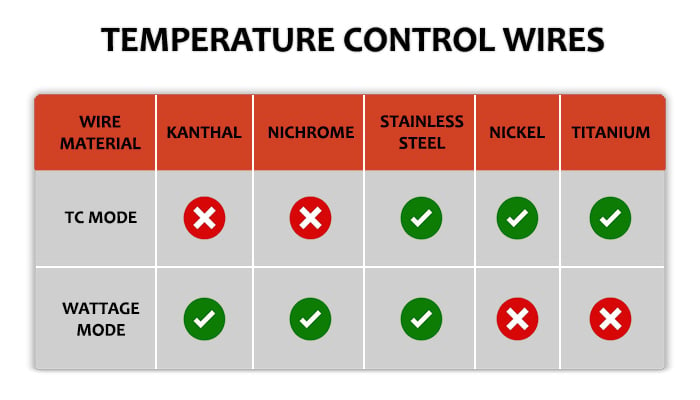
The Temperature Coefficient of Resistance (TCR)
Each wire type discussed has its own Temperature Coefficient of Resistance (TCR). A temperature coefficient expresses the gradual change in the physical properties of the wire as the temperature changes (a property required for TC vaping as discussed earlier).
This specific TCR value of the wire is kept in mind by the vape mod, allowing it to adjust the amount of power being sent to the coil and thus control the temperature. Some vape mods available on the market will have the TCR value preset for stainless steel (316L), Ni200, and Titanium.
However, with different grades of metal having different TCR values, the user can only install wire that is compatible with this preset TCR value. To overcome this issue, devices with customizable TCR values were introduced. With this feature, you can set the value of the TCR on your kit according to the wire you bought; simple!
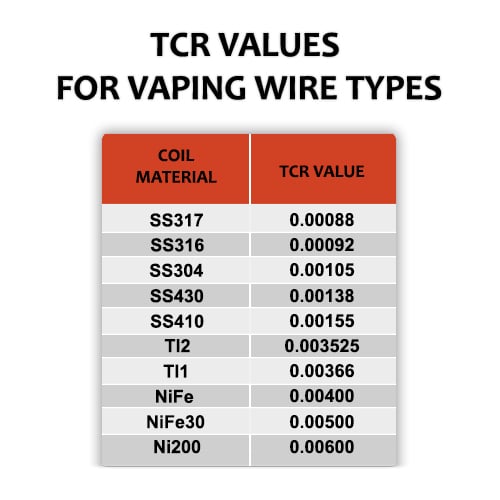
How to Vape with Temperature Control
Let us now have a look at the required steps to start TC vaping so that you can get the best experience out of it.
Firstly, turn on your device and put it into temperature control mode. If your device allows you to adjust the TCR value for your coil material then you can do so now. If not, choose the type of wire that your coil is made of. D
uring this process both your coil and device should be at room temperature in order to ensure the accuracy of temperature readings which the device will note later while you vape. To ensure that your device and tank are at room temperature, don’t use them for at least 5 minutes before starting this process.
Next, install your coil. If you’re using a tank that takes prebuilt, store-bought coils, ensure that it’s either screwed into the tank tightly or pushed into the tank all the way. Once your coil is installed you can fully assemble the tank and install it onto your mod.
Make sure that your tank is tightly screwed onto your mod (not too tight though) and examine the screen in order to verify that the resistance value is accurate. If it is, lock the resistance on your mod. How to do this varies by device.
If you’re using a rebuildable coil, dry burning is not recommended. Instead, space your coil nice and neatly in order to avoid hot spots. Skipping the dry burning process will allow your device to measure the resistance reading more accurately and provide a smoother, more consistent vaping experience.
Some devices available on the market will automatically adjust the wattage in TC mode, but some mods will allow you to set both the wattage and temperature. If your mod lets you change the wattage, you should set your wattage and temperature to the lowest value printed on the coil and go from there. You can gradually raise the wattage and the temperature as you vape in order to suit your preferences.
Last but not least, don’t forget to add in your e-juice and allow a few minutes for your wicks to become saturated.
What is the Best Temperature To Vape At?
Now that your device is on the ready, let’s talk about one of the most confusing factors involved in TC vaping — choosing the right temperature to vape at.
The best-recommended temperature to vape at ranges from 390°F to 480°F (200°C to 250°C), but it all comes down to personal preference. We recommend starting on the lower end of this temperature range and increasing the temperature in increments of 10°F at a time.
While doing this, note your temperature on the screen and test the feel of the vape, and eventually you will reach a point where the vapor feels just right. With the correct value, you will be able to take long, smooth hits without burning the coil or wick in the process.
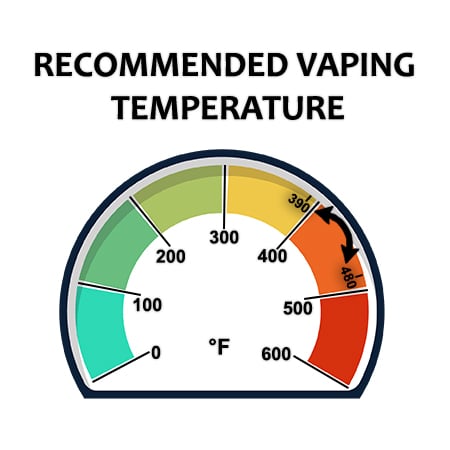
If your mod allows you to adjust the wattage, play around with this too. The set wattage will determine how quickly your coil will reach your set temperature so this will also affect the length of draws that you can take before the vapor drops off completely.
TC vaping is all about preference! If you want cooler vapor, lower the temperature. If you want your vapor to be a bit hotter, increase the temperature! By experimenting with this temperature value, you’ll eventually find a spot that seems just right. Time and then, you can also change the value to get a different experience for a change. It is important to note that the temperature can have a direct impact on the amount of moisture in the vapor produced.
If you feel the hit to be on the dry side, lower the temper in order to rejuvenate the moisture. Again, with some trial and error, you will eventually find the right temperature values for your liking.
The Upsides and Downsides of Temperature Control Vaping
Now that you have a basic idea on what TC vaping is and how to start, it is time to briefly talk about some common pros and cons; every good thing comes with its own set of advantages and disadvantages and, while it seems all peachy, TC mode is no different.
Pros of Temperature Control Vaping
Prevents dry/burnt hits: Dry and burnt hits can be prevented in several ways but the main advantage of temperature control is that it automatically does that for you. When your wick is running dry your coil temperature will rise and temperature control will step in and decrease the supply of power. Instead of getting a dry hit, you’ll just get less dense vapor. That’s it! No unpleasant hit or a burnt coil!
Longer coil and wick life: To avoid bad hits during wattage mode vaping, it’s up to the user not to overheat the coils. TC vaping does this for you by keeping the temperature under control. As a result, your cotton is never burnt or singed. Additionally, temperature control coils and wicks may also last longer than normal coils because they aren’t exceeding the temperature needed for a good vape.
Improved battery Life: As far as battery life is concerned, TC vaping is much more efficient than wattage mode vaping. It’s estimated that a temperature control vape uses 1.5 times less power than a wattage mode vape mod. This is because the temperature control vape mod uses less power to maintain the coil at the selected temperature.
Consistent draws: Perhaps the biggest advantage of temperature control vaping is that it provides consistent and quality vapor with every puff. This is achieved by having control over the temperature of the coil. The hits are less steady in wattage mode because the temperature of the coil changes based on the length of the hit.
Cons of Temperature Control Vaping
Not as straightforward as wattage mode: Normally, wattage mode is simpler and more natural to work with. You just set your desired wattage and vape; it is as simple as that. On the other hand, using temperature control mode requires finding a material you like, selecting the correct TC mode or inputting the correct TCR value, setting the wattage (if the mod allows), and then going through the process of trial and error before you find a temperature that you like. All of these steps increase the complexity of TC vaping versus wattage mode vaping.
You need a good TC mod: Not every temperature control mod available on the market is good and/or reliable. Most of the lower-priced temperature control mods available have many limitations and shortcomings. Make sure to do proper research on temperature control mode devices before buying one.
You can only use certain materials: Another disadvantage is the selection of coil materials. The most famous and most commonly used coil metal used in temperature control vape mods is stainless steel, but most pre-built coils don’t have a stainless steel options. Most coils for sub ohm tanks are still made of kanthal so unless you’re using a rebuildable atomizer and building your own coils, it might be hard to vape in TC mode.
Conclusion
Temperature Control Vaping is the way to go if you want to customize your vaping experience and like your draws to be consistent every time you take a puff.
This vaping mode brings a lot of involvement for the user as they have the option to select the nature of their vapor, all by controlling the temperature itself. It comes with its advantages and disadvantages but if used properly, temperature control mode vaping can be an exciting experience for the vaper because it provides the reliability and consistency that wattage control vaping lacks.
With temperature control vaping technology, problems like dry/burnt hits, and vapes that get too hot with long draws, are completely solved. Regular wattage control vaping is still popular among vapers but a trend shift is being observed, with more and more people taking up TC vaping. For this reason, companies are trying their best to make temperature control vape mods more beginner-friendly and easier to use.
If you are fed up with dry hits and burnt wicks/coils and you want a hassle-free vaping experience, it is time to give TC a try. Once you find your ‘just-right temperature’ you are sure to love it!

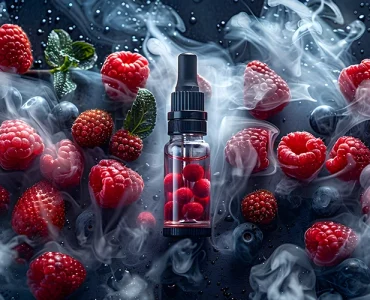



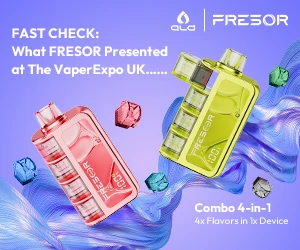
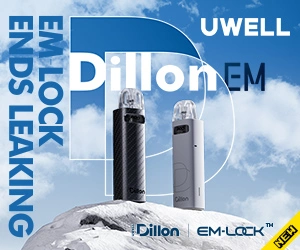

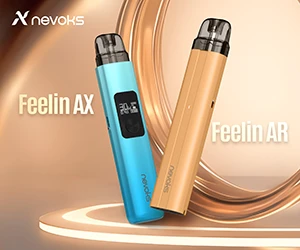
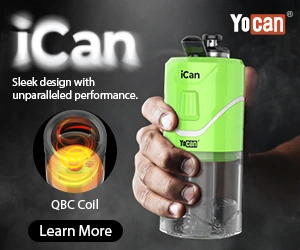
Add comment